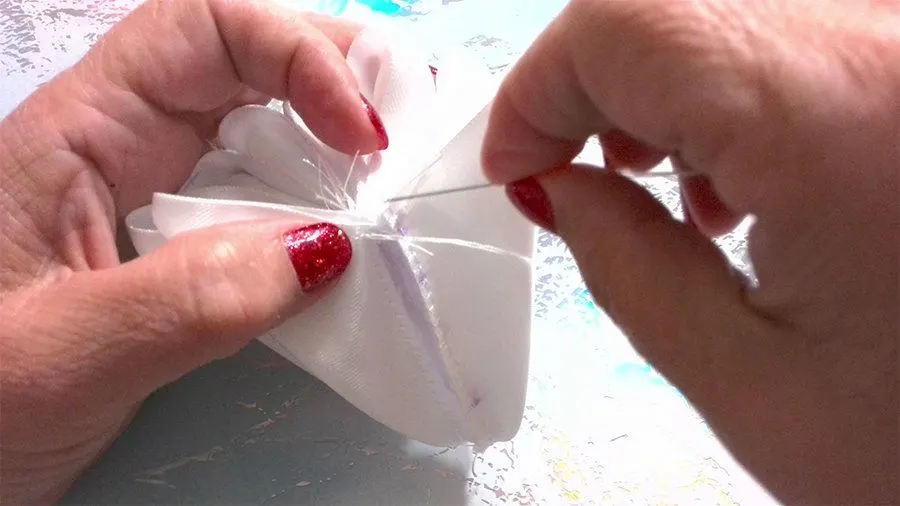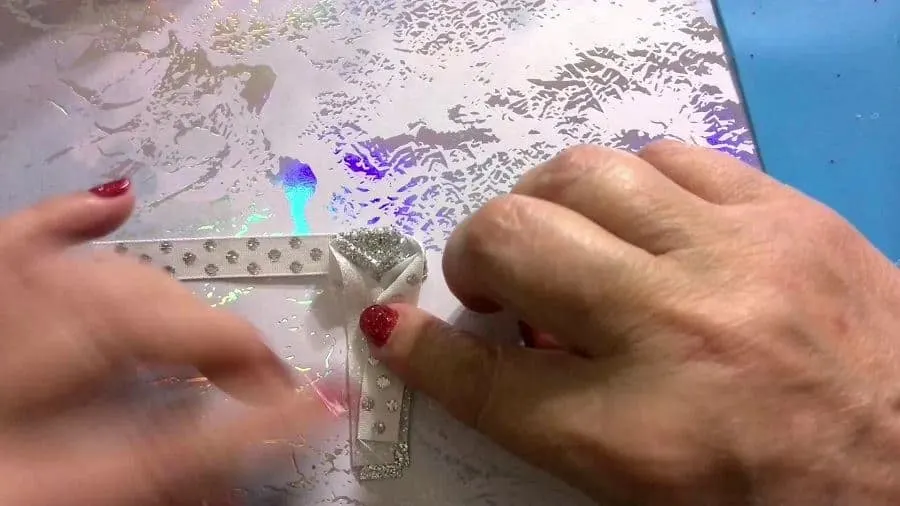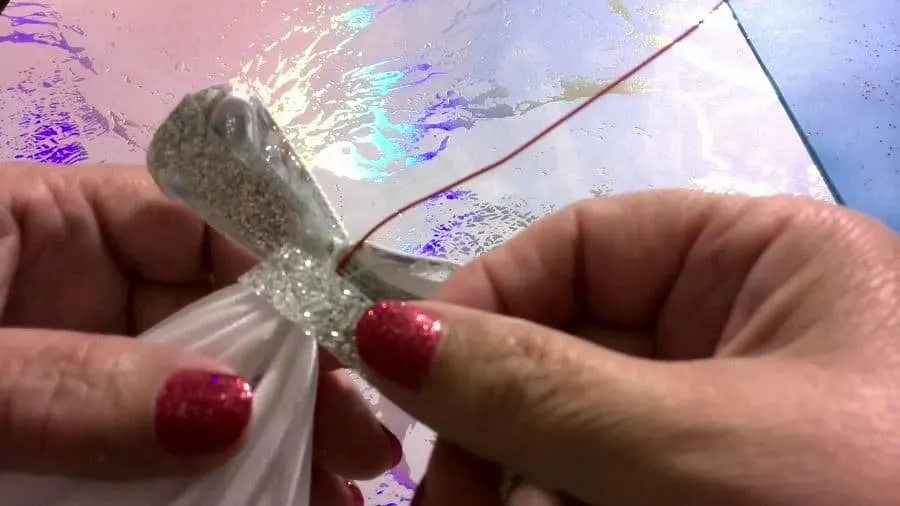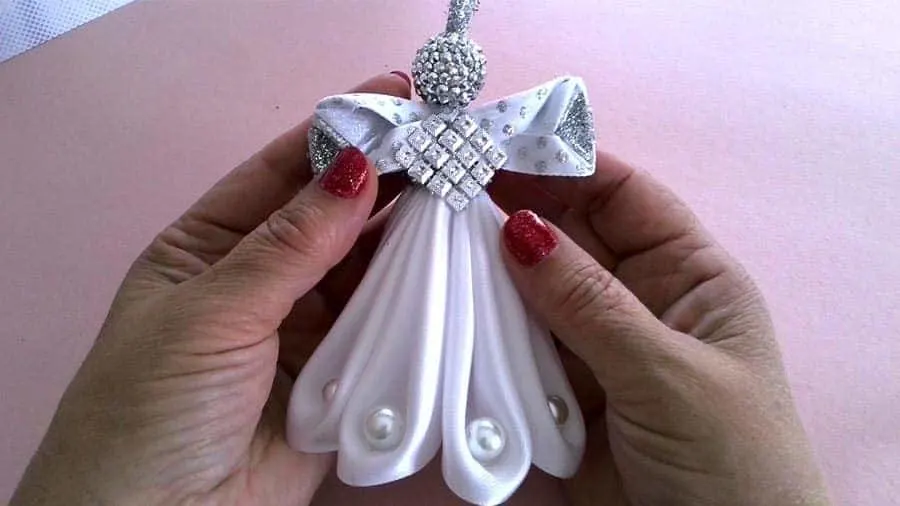Nothing says “Christmas” better than an angel ornament! An angel is one of the main symbols of Christmas. No Christmas tree is complete without angel ornaments.

In this tutorial, I will show you how to make such an ornament.
Why make it, when you can buy it everywhere? Well, simple: handmade by you, it will be probably special for you and your family forever. It may even be a treasured memory long after we are gone, and like any other treasured memory, will probably be taken out every Christmas or special occasion and allow the family to come together even if only for a while.
And there is another reason: it is very beautiful!
Tools and materials
- satin ribbons (2 1/2″) and decorative ribbons (3/8″)
- pearl beads (I used 8mm)
- bigger bead for the top
- lighter or candle (very important notes below)
- sharp scissors
- hot glue gun and glue
- tweezers
- thin wire (0.8mm or AWG20)
- ornamental ribbons as desired
- thread, needles for sewing
All materials used are presented in the image below:

Note: Some of the links on this page are affiliate links. This means I will receive a commission if you order a product through one of my links. I only recommend products I believe in and use myself.
It’s important to choose the right ribbon. Not all types of ribbons are suitable, only satin ribbons will do as they are the most pliable and smoothest. They also keep their shape well and shine. I prefer not wired ribbons. Most of them are wired now as I see in Hobby Lobby but you can easily find not wired ribbons online. Satin ribbons might be single-faced and double-faced. Single faces are smooth and shiny only on one side and double-faced are smooth and shiny on both sides.
I think it is best to use 2.5 inches wide ribbons even if they are not as easy to find as the more common 1.5″ ones. A 2.5 inches wide ribbon is easy to fold and is more convenient. It’s important to choose the right ribbon to use, it keeps its shape well and is not too difficult to handle. Smaller ribbons are more difficult to work with.
Use only satin ribbons made from synthetic materials (polyester and nylon). Don’t use ribbons made from natural silk. For no-sew projects, where the material is not in contact with skin, I prefer to work with artificial fibers: they melt but don’t burn, and polyester is a flame-resistant material.
I also used 3/8″ wide ribbons and 1/4″ wide ribbons like the ones below:
I suggest reading the whole tutorial BEFORE attempting to make this, in my process, I made a mistake at some point and I did not realize it until much later. Read further and all will become clear 😀
All dimensions below are given in inches. For a quick conversion to centimeters an inch can be taken as 2.54cm (or 25.4mm), therefore 2.5” is 6.4cm (actually, 6.35cm) and 5” is 12.7cm. A very useful calculator for conversions between units of measurements for sewing projects can be found here: Fabric Conversion Calculator
All subscribers to my newsletter can download for free a printable version of this article from my Resource Library page.
Step 1. Cut 10 Rectangles
Begin the process by cutting 10 rectangles from the ribbon, each 5” long (if you use a 2.5” ribbon as I did). The rectangles must have a 2:1 ratio for the two sides, and since our ribbon is 2.5” wide we will cut 10 pieces each 5” long.

Step 2. Fold Corners
Fold the rectangles like in the image below starting with one corner, then seal the corner so folded so it will stay put. We need to either sew this together (which is possible) or because my polyester ribbon is melting in the flame I chose to seal the corners using the flame.

I use a lighter to do that, and I am showing it in the second image. Just touch the ribbon briefly close to the middle and then smooth it between your index finger and thumb. Test it first on a piece of scrap ribbon, until you get the hang of it. If done correctly, the material will melt just a little at the very edges, and that is all we need.
It is safe to touch the material immediately after, it will be warm but not very hot.
For my previous DIY Christmas ornament (Unique DIY Christmas Ornament) I used a small candle but here because I only had a small point to seal I decided to use a lighter, just to see if it makes any difference. It does not, really – you can use whatever you want.
IMPORTANT SAFETY NOTE
Every time you are working with an open flame, as will be the case here, you will need to pay special attention to your safety and take extra care.
- Never leave the flame unattended
- Always extinguish the flame when you are done or when you take a break
- Never leave flammable materials around the flame
- Handle with care any materials near the flame
- Always keep your kitchen fire extinguisher handy
- Work with flame near your kitchen sink
- Fire is not a toy; never leave children, especially small children, around the candle or alone in a place where fire can be easily started
I am sure everyone is reasonably familiar with these precautions nevertheless house fires are quite frequent which means it does not hurt to reiterate them again.
Also an important note: any fire creates smoke. This may taint your ribbon, keep the ribbon well away from the flame and make sure smoke is not a problem. If your candle somehow smoked the ribbon, that piece is pretty much lost – you will never be able to take the smoke out.

Repeat the operation with the second corner like in the image below. If you will look at the left side of the image you will see the already folded rectangles prepared for the next step.

Repeat this operation for all initial rectangles (all 10).
Step 3. Fold into Triangles
Fold the processed rectangle in half as in the image below. The result will be a folded triangle.

The triangle obtained tries to unravel; use a clip (called a Wonder clip) to keep the corner in place. Use the clip not on the fold but on the two separate corners that came together in folding.
A little bit later in the process, we will sew this triangle on the general line shown by the ruler in the image below. Remember this later when we will reach that point. For now, we put back the clip to keep the corner in place and just mark the line.

Step 4. Mark the Stitching Line
I measure about ⅝” from the lower corner (not the one with the clip) and draw a line using a fabric marker from the corner held by the clip to that point like in the image below. You don’t need to actually draw these lines on the ribbon, I did it just to show you where you have to stitch.

Step 5. Stitch along the lines using your sewing machine
Sew along the lines marked at the previous step not shown in the images). Repeat the operation for all 10 pieces. After this we end up with 10 pieces that look like this:

Step 6. Cut Unused Corner
Cut the corners outside the seams very carefully, at about 1/16” distance from the seam (2mm). Close enough to have only a negligible amount left but not close enough to invite unraveling or to touch the seam.

Repeat the operation for all 10 pieces. Discard the cuttings, they are not useful anymore.
These 10 pieces will become the dress of the angel.
Step 7. Mount Beads
Take a piece of craft wire. It is about 0.8mm in diameter and for all purists out there that translates into American Wire Gauge 20. But of course, I got it in the craft store and there is no diameter on the label, it is simply wire for crafts. The length of the wire is about 5” or so, comfortable to work with (12.5cm). This wire is only a prop, a tool used to place the bead in the fold.
I decided to use this wire tool to set the beads because it is quite difficult to do it by hand, the beads are small and with a drop of hot glue on them, there is no margin of error there. The wire makes it easy to manipulate the bead.
Place a bead on the wire and put a small drop of hot glue on it. Then we place the bead in the fold of one of the triangles prepared above like in the image below:

When the bead is in the fold press gently with your finger to make sure it sets properly. After a second or two the glue is cool and we can retrieve the wire, the bead remains in the fold.
Repeat the operation with all 10 pieces.
If somehow you are not satisfied with how one bead was set and you want to move it a little, it is possible to do that for one or two seconds before the hot glue sets completely. You just have to be quick about it.

After this operation we now have all 10 petals of the angel’s dress; we have to put them together.
Step 8. Make Angel’s Dress – Sew by Hand
Take a piece of thread and thread a hand sewing needle.
Then string all 10 pieces prepared above on the needle-like in the image below:

When you have all 10, sew them together at the top making sure the stitch does not unravel. You will get an unorganized bunch like this below

Repeat the operation with the bottom of the angel’s dress. Again, string all 10 pieces together, sew and secure the seam.


After this step the dress is ready! All it needs now is a little arranging by hand to make the ten petals symmetrical. The end result is like this:

Step 9. Build Angel’s Wings
We have now to build the rest of the angel’s body and I use the decorative ribbons to build the wings first. These ribbons are 3/8″ (1cm) wide.
Cut four pieces of about 5” (about 13cm). The measurement does not need to be very exact, we will cut them later.
We need actually to make two constructions like the one I will present next, so we will need in fact double the number of small ribbon pieces, but of course, the second one will be identical.

Three of them stack on top of each other. Drop a little hot glue at the middle of one strip, then lay over it the second one. Then repeat the process for the third strip, put a drop of hot glue at the center of the second strip (which is now on top) then place the third one over it. We end up with a “sandwich” of three strips.



For the fourth strip, we fold it in half to obtain the center, then we put about 1/2” of hot glue over this fold, half on one side, and half on the other like in the image below.

Then we lay the “sandwich” on top of this ribbon aligning the upper side with the fold line. I am trying to place this last ribbon in the middle of the other three, but I do not need to measure, eye approximation is enough.

Then fold this last ribbon over to seal all four.

Then fold the three ribbons sandwiched together over the fourth one like in the images below. Beware you will need to be patient with arranging these.



Secure the construction with a clip like in the image below.
Then make a second one, identical to the first. These are going to be the angel’s wings.

As you can see we did not arrange the wings perfectly, the ends do not really align properly. This is in part because we started with ribbons of the same length (and the folds are not really the same, the ones folded last will come out shorter), and in part, because we did the operation by hand without measuring, so minute differences may appear between the two items.
This is ok, we will now trim the wings to the same length, cutting a little from the tip. How much do you cut? Up to you. I think I cut about ⅝” or thereabout, but I did not measure exactly. I use my tweezers to hold the ribbons.

Now, while the wing is still held in the tweezers, I will seal the cut end so it will not unravel. The cut will be hidden under some other embellishment in the end.

We repeat the operation with the second wing. Then we glue the two wings together, tip to tip; we use hot glue for this. They will not really overlap, they will be just kept together by the hot glue. In the end, we get this. Beware, this is not really a sturdy construction at this point, but it stays together.

Wait a couple of minutes and allow for the glue to cool down and harden, we need the wings to stay together.
With this the wings are ready.
Step 10. Build the Angel’s Body
At this point, I realized I made a small mistake. I need a craft wire to protrude from the angel’s dress upwards to anchor to it the wings and the rest of the angel. But I did not put the wire in when sewing the dress, which I should have done. So at this point, I inserted a wire through the stitch at the top of the angel’s dress and I tucked the wire between the folds. Ideally, the wire should have been sewn together with the petals at step 8.
However this was not a major issue, it was not really difficult to insert the wire in the stitch, the wire is thin enough so I decided to continue and not redo the steps. But this is worth mentioning as an improvement.
The wire inserted in the dress looks like this. It is almost as long as the dress but does not go out through the bottom or it will be seen.

Place some hot glue on top of the dress where the wire protrudes and then mount the wings. You will need an amount of glue larger than a drop but not excessive.
Wait a couple of minutes, and allow the glue to cool down and harden.
The winds mounted to look like this:

After the wings are in place take a small piece of narrow ribbon (about 2”, 5cm) and make a belt for the angel. I measured first how long that has to be.
Start with a drop of hot glue.

Roll the ribbon around the waist of the angel until it comes back to the original point. It should overlap ½” or so, enough to allow it to be glued. Place a small amount of glue and fold the ribbon over. Wait a couple of seconds – now the angel has a belt under its wings.

The belt does not need to be tight around the dress, it needs to have a little volume, but it can not be loose to allow movement either.
At the back of the wings the mounting wire can be seen so I am going to hide it with a square piece of decorative ribbon, 1” on each side. The front of the wings also needs embellishment because the joining line between the wings can be seen therefore I am going to use two squares, mounted with a little hot glue.
I do not remember exactly where I have the ribbon from, but similar items are below. It is easy to cut it to the desired size.

In my process, I had to go back and apply a little hot glue to the corners of the square to make it stick better, just a drop of glue in the middle was not enough. I actually put more than a drop, I made a vertical line of glue about ½” long, but the sides were flapping so I had to secure them.
As you can see the top of the shiny square goes a little above the center of the wings and is about at the same height level as the tip of the wings. This is a personal preference, not a rule.
Step 11. Angel’s Head
For the head, I used a bigger bead (about 4/5″, or 20mm), and for the loop (to put it in the tree) a piece of decorative craft wire as in the image below. The decorative wire goes through the bead together with the mounting wire we used before.

As you can see in the image the decorative wire goes through the bead, barely showing at the other end. The craft wire we inserted in the dress is still used as support here.
Then place a small drop of hot glue like in the image below, then set the head and keep it in place until the glue hardens. Be patient!
The image below shows this step:

The glue will keep together the initial mounting wire, the craft (silvery) wire we will use for the loop, the large bead (head), and will also touch the wings, dress, and the two squares we used in step 10.
Step 12. Make the Loop
After the head is secure on the body trim the craft wire to the point where it exits the bead. The silver wire must also be trimmed to the exact length required for the mounting loop. Then I used a drop of hot glue to secure the end of the silver wire to the head like in the image below.

If you wish, you can also use a little metallic wire (or thread) and wrap it around the glued point to secure the loop, but I did not do that.
The ornament is ready! Was it difficult? I don’t think so and it certainly is beautiful. I may be biased, I know.
My angel seems to be sturdy enough and has already survived a trip outside (I wanted to take an image with a tree) and a couple of falls so I am confident it will be a nice addition to my tree come Christmas time!

If you would like to see a video tutorial on easy angel ornaments to make go to my YouTube channel
Did you find this tutorial helpful? If so, save this pin (see below) on your sewing board so you can come to this tutorial later when you are ready to make DIY angel ornaments, and follow me on Pinterest for more tips, tutorials, and inspiration!

Remember, subscribers to my newsletter can download for free a printable version of this article from my Resource Library page!
latest posts
- Ever Tried This on Your Serger? This Differential Feed Feature Will Amaze You
- Ditch My Sewing Machine? Not in This Lifetime!
- Adorable DIY Needle Book | Easy Tutorial for Beginners
- Master the Seam Ripper: Your Ultimate Guide to Precision Stitch Removal
- Think You Know Zippers? This Installation Guide Might Surprise You
- Why Does Your Seam Ripper Have a Red Ball? Discover Its Purpose!
- Topstitching Troubles? This Simple Trick Will Turn It Around Instantly!
- How to Sew Shirring: A Step-by-Step Guide to Elastic Thread Gathering
- Are Self-Threading Needles Really Useful?
















